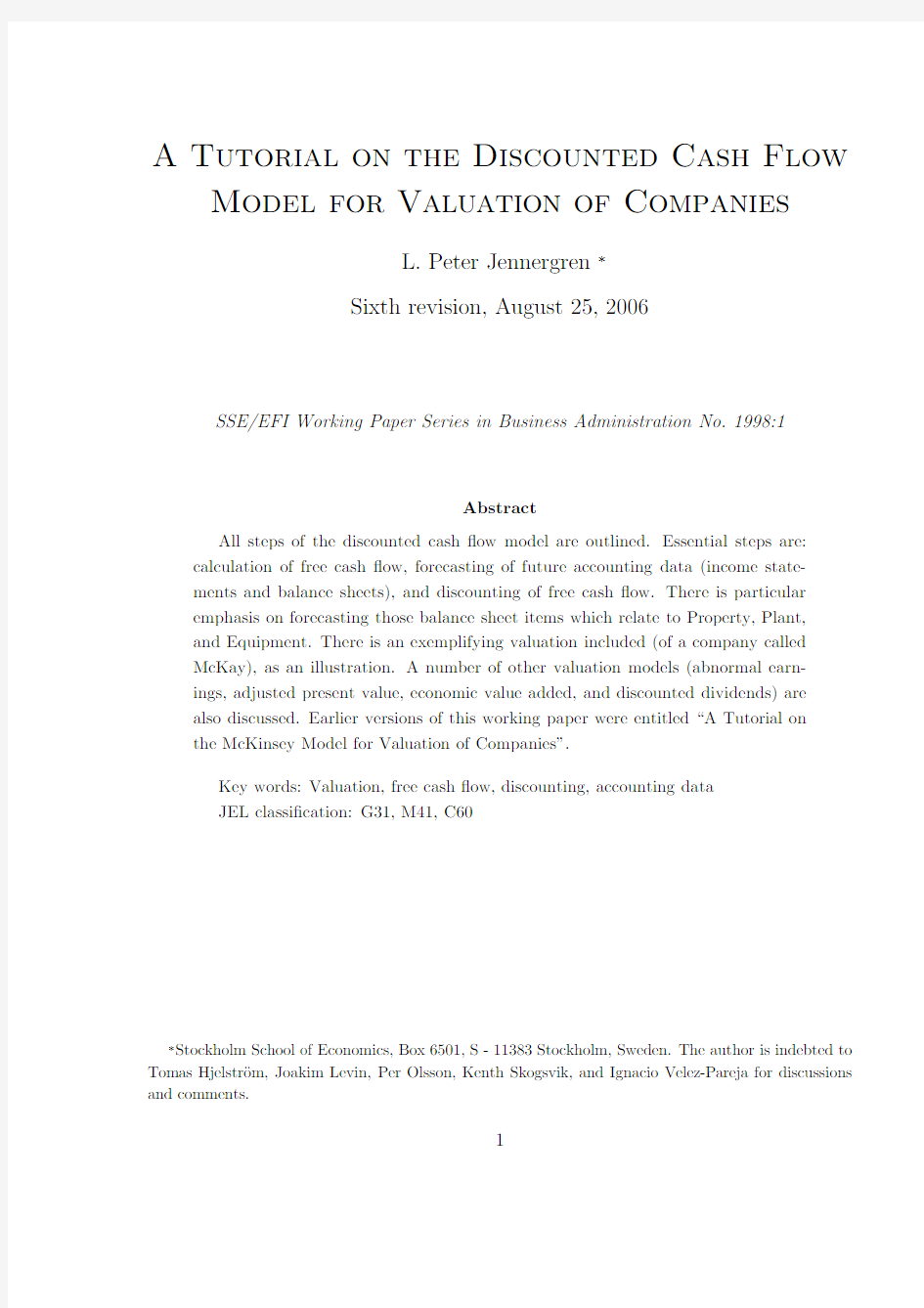麦肯锡公司价值评估经典模型

- 1、下载文档前请自行甄别文档内容的完整性,平台不提供额外的编辑、内容补充、找答案等附加服务。
- 2、"仅部分预览"的文档,不可在线预览部分如存在完整性等问题,可反馈申请退款(可完整预览的文档不适用该条件!)。
- 3、如文档侵犯您的权益,请联系客服反馈,我们会尽快为您处理(人工客服工作时间:9:00-18:30)。
A Tutorial on the Discounted Cash Flow
Model for Valuation of Companies
L.Peter Jennergren∗
Sixth revision,August25,2006
SSE/EFI Working Paper Series in Business Administration No.1998:1
Abstract
All steps of the discounted cashflow model are outlined.Essential steps are: calculation of free cashflow,forecasting of future accounting data(income state-
ments and balance sheets),and discounting of free cashflow.There is particular
emphasis on forecasting those balance sheet items which relate to Property,Plant,
and Equipment.There is an exemplifying valuation included(of a company called
McKay),as an illustration.A number of other valuation models(abnormal earn-
ings,adjusted present value,economic value added,and discounted dividends)are
also discussed.Earlier versions of this working paper were entitled“A Tutorial on
the McKinsey Model for Valuation of Companies”.
Key words:Valuation,free cashflow,discounting,accounting data
JEL classification:G31,M41,C60
∗Stockholm School of Economics,Box6501,S-11383Stockholm,Sweden.The author is indebted to Tomas Hjelstr¨o m,Joakim Levin,Per Olsson,Kenth Skogsvik,and Ignacio Velez-Pareja for discussions and comments.
1Introduction
This tutorial explains all the steps of the discounted cashflow model,prominently featured in a book by an author team from McKinsey&Company(Tim Koller,Marc Goedhart,and David Wessels:Valuation:Measuring and Managing the Value of Compa-nies,Wiley,Hoboken,New Jersey;4th ed.2005).The purpose is to enable the reader to set up a complete valuation model of his/her own,at least for a company with a simple structure.The discussion proceeds by means of an extended valuation example.The company that is subject to the valuation exercise is the McKay company.1 The McKay example in this tutorial is somewhat similar to the Preston example (concerning a trucking company)in thefirst two editions of Valuation:Measuring and Managing the Value of Companies(Copeland et al.1990,Copeland et al.1994).How-ever,certain simplifications have been made,for easier understanding of the model.In particular,the capital structure of McKay is composed only of equity and debt(i.e., no convertible bonds,etc.).Also,McKay has no capital leases or capitalized pension liabilities.2McKay is a single-division company and has no foreign operations(and con-sequently there are no translation differences).There is no goodwill and no minority interest.The purpose of the McKay example is merely to present all essential aspects of the discounted cashflow model as simply as possible.Some of the historical income statement and balance sheet data have been taken from the Preston example.However, the forecasted income statements and balance sheets are totally different from Preston’s. All monetary units are unspecified in this tutorial(in the Preston example in Copeland et al.1990,Copeland et al.1994,they are millions of US dollars).
This tutorial is intended as a guided tour through one particular implementation of the discounted cashflow model and should therefore be viewed only as exemplifying:This is one way to set up a valuation model.Some modelling choices that have been made will be pointed out later on.However,it should be noted right away that the specification given below of net Property,Plant,and Equipment(PPE)as driven by revenues agrees with Koller et al.2005.Thefirst two editions of Valuation:Measuring and Managing the Value of Companies contain two alternative model specifications relating to investment
1Previous versions of this tutorial were entitled“A Tutorial on the McKinsey Model for Valuation of Companies”,since they focused on the McKinsey implementation of the discounted cashflow model. However,after several revisions of the McKinsey book as well as of this tutorial,there are now some differences in emphasis and approach between the two,motivating the title change.Otherwise,the most important changes in the sixth revision of this tutorial are as follows:The working capital items inventories and accounts payable are now driven by operating expenses,rather than by revenues.Section 15and Appendix2are new.
2Pension contributions in McKay may hence may be thought of as paid out to an outside pension fund concurrently with the salaries generating those contributions,so no pension debt remains on the company’s books.
